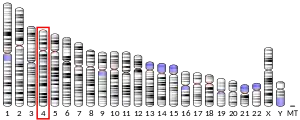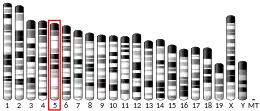Chemokine (C-X-C motif) ligand 3 (CXCL3) is a small cytokine belonging to the CXC chemokine family that is also known as GRO3 oncogene (GRO3), GRO protein gamma (GROg) and macrophage inflammatory protein-2-beta (MIP2b). CXCL3 controls migration and adhesion of monocytes and mediates its effects on its target cell by interacting with a cell surface chemokine receptor called CXCR2.[5][6] More recently, it has been shown that Cxcl3 regulates cell autonomously the migration of the precursors of cerebellar granule neurons toward the internal layers of cerebellum, during the morphogenesis of cerebellum.[7] Moreover, if the expression of Cxcl3 is reduced in cerebellar granule neuron precursors, this highly enhances the frequency of the medulloblastoma, the tumor of cerebellum. In fact, the reduced expression of Cxcl3 forces the cerebellar granule neuron precursors to remain at the surface of the cerebellum, where they highly proliferate under the stimulus of Sonic hedgehog, becoming target of transforming insults. Remarkably, the treatment with CXCL3 completely prevents the growth of medulloblastoma lesions in a Shh-type mouse model of medulloblastoma.[8] Thus, CXCL3 is a target for medulloblastoma therapy. Cxcl3 is directly regulated transcriptionally by BTG2[7]
The gene for CXCL3 is located on chromosome 4 in a cluster of other CXC chemokines.[9]
References
- 1 2 3 GRCh38: Ensembl release 89: ENSG00000163734 - Ensembl, May 2017
- 1 2 3 GRCm38: Ensembl release 89: ENSMUSG00000058427 - Ensembl, May 2017
- ↑ "Human PubMed Reference:". National Center for Biotechnology Information, U.S. National Library of Medicine.
- ↑ "Mouse PubMed Reference:". National Center for Biotechnology Information, U.S. National Library of Medicine.
- ↑ Smith DF, Galkina E, Ley K, Huo Y (November 2005). "GRO family chemokines are specialized for monocyte arrest from flow". Am. J. Physiol. Heart Circ. Physiol. 289 (5): H1976–84. doi:10.1152/ajpheart.00153.2005. PMID 15937099.
- ↑ Ahuja SK, Murphy PM (August 1996). "The CXC chemokines growth-regulated oncogene (GRO) alpha, GRObeta, GROgamma, neutrophil-activating peptide-2, and epithelial cell-derived neutrophil-activating peptide-78 are potent agonists for the type B, but not the type A, human interleukin-8 receptor". J. Biol. Chem. 271 (34): 20545–50. doi:10.1074/jbc.271.34.20545. PMID 8702798.
- 1 2 Farioli-Vecchioli S, Cinà I, Ceccarelli M, Micheli L, Leonardi L, Ciotti MT, De Bardi M, Di Rocco C, Pallini R, Cavallaro S, Tirone F (October 2012). "Tis21 knock-out enhances the frequency of medulloblastoma in patched1 heterozygous mice by inhibiting the cxcl3-dependent migration of cerebellar neurons". The Journal of Neuroscience. 32 (44): 15547–15564. doi:10.1523/JNEUROSCI.0412-12.2012. PMC 6621585. PMID 23115191.
- ↑ Ceccarelli M, Micheli L & Tirone F (2016). "Suppression of Medulloblastoma Lesions by Forced Migration of Preneoplastic Precursor Cells with Intracerebellar Administration of the Chemokine Cxcl3". Frontiers in Pharmacology. 7: 484. doi:10.3389/fphar.2016.00484. PMC 5159413. PMID 28018222.
- ↑ O'Donovan N, Galvin M, Morgan JG (1999). "Physical mapping of the CXC chemokine locus on human chromosome 4". Cytogenet. Cell Genet. 84 (1–2): 39–42. doi:10.1159/000015209. PMID 10343098. S2CID 8087808.
External links
- Human CXCL3 genome location and CXCL3 gene details page in the UCSC Genome Browser.



